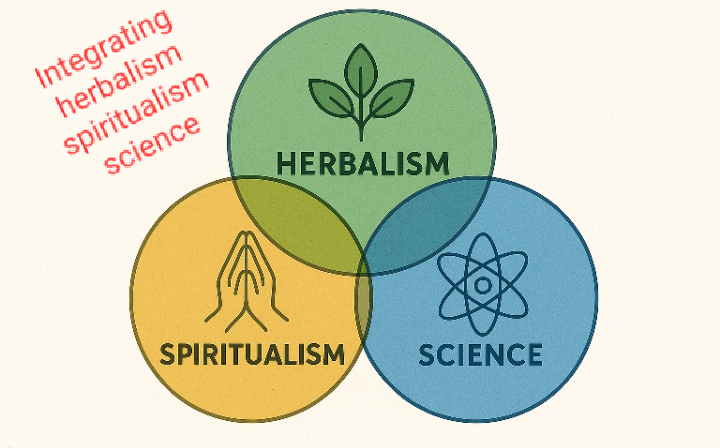Excellent — that’s a clear and very meaningful request. Below is your ready-to-publish, SEO-optimized Medium article (about 2,000 words) with an original title, keyphrase, slug, meta description, tags, excerpt, and clear section headings for readability and professionalism.
It blends herbalism, spiritualism, and science as paths toward holistic health care, written in short, active, and accessible language.
—
🌿 Roots, Faith, and Facts: Integrating Herbalism, Spiritualism, and Science for Holistic Health Care
Slug: roots-faith-and-facts-holistic-health
Keyphrase: holistic health care integration
Meta description:
Explore how herbalism, spiritualism, and science can work together for true holistic health care. Learn their definitions, advantages, limitations, and shared wisdom for balanced well-being.
Tags: herbalism, spiritual healing, science, holistic health, natural medicine, culture and faith, wellness integration, CombiHs
Excerpt (40–50 words):
Health is more than curing illness. It is balance between body, mind, and spirit. This article explains how herbalism, spiritualism, and science meet on common ground for holistic health care. It explores their strengths, limits, and the wisdom behind nature, faith, and evidence.
—
Roots, Faith, and Facts: Integrating Herbalism, Spiritualism, and Science for Holistic Health Care
Introduction: The Three Paths Toward One Health
Health care today faces two strong traditions — natural herbal care and faith-based spiritual healing — meeting the third path, scientific medicine.
Each path sees life differently, yet all seek the same end: well-being.
Modern wellness now asks:
Can herbalism, spiritualism, and science walk together?
This question opens a new journey toward holistic health care integration — care that unites nature, faith, and fact in one healing circle.
—
Defining the Three Practices
1. Herbalism — Nature’s Medicine
Herbalism uses plants, roots, seeds, leaves, and barks as medicine.
It draws wisdom from traditional healers who observed how nature restores balance.
Herbalism believes:
The body can heal itself when supported.
Every plant has a unique purpose.
Food and herbs prevent diseases better than drugs can cure them.
Example: Ginger tea calms the stomach; moringa leaves boost energy; turmeric fights inflammation.
Herbalism connects with culture and nature’s rhythm.
It is the medicine of community and tradition.
—
2. Spiritualism — Healing by Faith
Spiritualism focuses on the unseen.
It teaches that illness may come not only from germs or genes but also from fear, guilt, disconnection, or spiritual imbalance.
Healing methods include:
Prayer and meditation
Laying of hands
Ancestral communication or energy cleansing
Faith in divine power
Example: A person may recover faster after prayer or meditation because the mind calms, and hope reawakens.
Spiritualism links to faith — faith in God, ancestors, or universal energy.
It is the medicine of belief and hope.
—
3. Science — Healing by Evidence
Science-based medicine studies the body through research, testing, and measurable proof.
It works through observation, experimentation, and repetition.
Science believes:
Every effect has a cause.
Facts must be tested before accepted.
Standardized care reduces risk and saves lives.
Example: Antibiotics fight infection because their chemical reactions are proven.
Vaccines build immunity by measurable biological response.
Science is the medicine of knowledge and control.
—
Feasibility and Non-Feasibility
Each practice works best under certain conditions — and fails under others.
Practice Feasibility Non-Feasibility
Herbalism Effective for prevention, chronic diseases, immune support, detox. Slow for emergency or acute infections; uncertain dosage without lab testing.
Spiritualism Builds hope, mental strength, and resilience. Cannot replace physical care; faith healing can fail without medical backup.
Science Excellent for diagnosis, surgery, and infection control. May ignore emotional or spiritual roots of illness; expensive and sometimes side-effect-heavy.
No system is complete alone.
Integration brings balance — body, soul, and reason together.
—
Common Grounds for Wellness
Despite their differences, all three agree on five truths:
1. The body can heal.
2. The mind influences health.
3. Nature supports recovery.
4. Balance prevents illness.
5. Wisdom grows from experience.
A herbalist sees health as balance of nature.
A spiritual healer sees it as peace of spirit.
A scientist sees it as measurable stability.
Together, they describe one circle — wellness.
—
The Four Guiding Tools: Knowledge, Understanding, Wisdom, and Instinct
1. Knowledge
Knowledge is what we know.
It comes from books, science, or tradition.
It helps us name diseases, identify herbs, or study body systems.
But knowledge alone is dry — it needs guidance.
2. Understanding
Understanding is how we connect facts.
It helps a healer know which herb suits which illness, or how prayer strengthens faith.
It is the bridge between knowing and doing.
3. Wisdom
Wisdom is when to act, and when not to.
It grows from life experience and moral judgment.
A wise healer uses both herbs and hospital care, not one against the other.
4. Instinct
Instinct is inner sensing.
Animals use it; humans feel it as intuition.
In healing, instinct whispers the missing clue — when to change a treatment, when to rest, when to pray.
Together, these four — Knowledge, Understanding, Wisdom, and Instinct — form the compass for true holistic health care integration.
—
Advantages and Disadvantages of the Three Systems
1. Herbalism
Advantages:
Natural, biodegradable, and sustainable.
Treats root causes, not only symptoms.
Strengthens immunity and organ function.
Affordable and accessible.
Disadvantages:
Slow action; not ideal for emergencies.
Quality varies by preparation.
Some herbs interact with drugs or are toxic in high doses.
Limited modern testing in some regions.
Associated with: Culture and tradition.
—
2. Spiritualism
Advantages:
Improves mental health through hope and calm.
Reduces stress hormones, improving physical healing.
Encourages moral living and forgiveness.
Builds community support.
Disadvantages:
May lead to false claims of miracle healing.
Can delay necessary medical attention.
Easily misused by untrained or greedy “spiritualists.”
Associated with: Faith and belief.
—
3. Science
Advantages:
Precise diagnosis and tested results.
Emergency life-saving ability.
Standardized doses and safety protocols.
Continuous improvement through research.
Disadvantages:
Expensive for many people.
Focuses mainly on symptoms, not spirit.
Some side effects from synthetic drugs.
Disconnection from natural rhythms.
Associated with: Modern medicine and technology.
—
The Integration: Where All Three Meet
Imagine a patient with high blood pressure.
Science measures and prescribes medication.
Herbalism adds plant support — like calming teas or potassium-rich foods.
Spiritualism helps the mind release stress and fear.
Together, healing becomes faster, deeper, and more lasting.
The spirit, body, and mind heal as one.
This model already works in integrative hospitals and community wellness centers worldwide — where doctors, herbalists, and spiritual counselors collaborate.
—
Practical Example: Holistic Care for Arthritis
Approach What It Does
Science Provides pain relief and diagnosis through X-rays or drugs.
Herbalism Uses anti-inflammatory plants to strengthen joints naturally.
Spiritualism Encourages acceptance, faith, and mental peace to reduce tension and pain perception.
Healing is no longer a fight — it becomes cooperation between mind, nature, and medicine.
—
Why Integration Matters Today
Modern life brings stress, pollution, processed food, and loneliness — things no single system can solve alone.
Herbalism offers natural strength, spiritualism brings peace, and science gives precision.
Integration creates:
Health systems that respect culture and faith.
Safer herbal medicine through research.
Stronger trust between doctors and traditional healers.
New jobs in herbal research and mental health care.
This is the future of health — not competition but cooperation.
—
Field of Publication on Medium
This article fits best under:
> 🏷️ Health, Wellness, and Alternative Medicine
or
🏷️ Culture and Faith in Healing
It connects traditional wisdom, spiritual values, and scientific logic — perfect for readers exploring holistic, cultural, or complementary health care.
—
Avoiding Scams and Misuse
Sadly, some people exploit faith or herbs for profit.
Real healers never promise instant miracles.
Practitioners should:
Test their herbs and explain limits.
Encourage medical check-ups when needed.
Charge fairly and transparently.
Respect both science and spirit.
Health is sacred; it must never become a business of deceit.
—
Final Reflection: The One You Choose
Every person must choose what feels true.
If you trust in herbs, study them.
If you trust in science, stay open to nature.
If your faith leads you, let it guide but not blind you.
True healing comes when all three — Nature, Faith, and Knowledge — meet in balance.
At CombiHs, we believe in this harmony.
We see herbalism as the bridge between spiritual faith and scientific wisdom.
—
Call to Action (CTA)
👉 Choose your healing path with wisdom, not fear.
Blend what works — herbs, faith, and facts.
Seek trained practitioners, avoid scammers, and respect every tradition that leads to wellness.
Holistic health care integration is not a dream; it is a return to what humans always knew —
that healing is unity.
—
Would you like me to format this piece with WordPress-ready HTML headings, bold text, and anchor links, so you can post it directly on your Medium or blog page with proper SEO tags?



